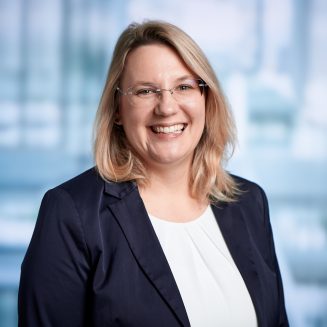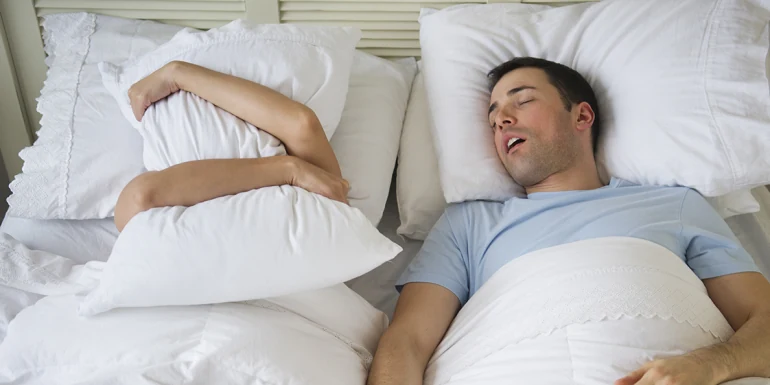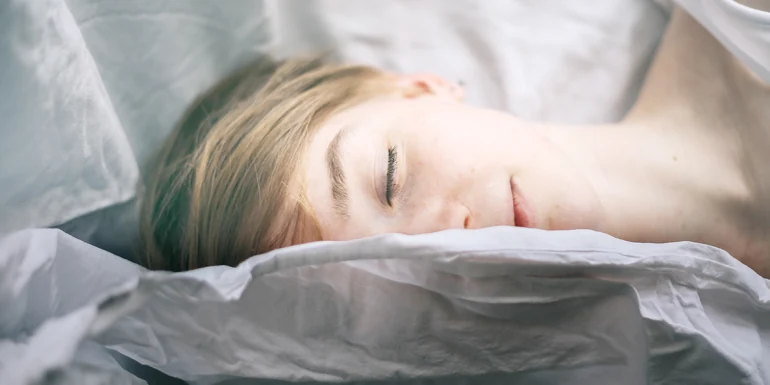
Sleep apnoea: causes and consequences
What causes sleep apnoea and what does treatment involve? Find out about sleep apnoea treatment with a splint or a CPAP machine and get tips on the subject of apnoea during sleep.
What is sleep apnoea?
Sleep apnoea is a breathing disorder that occurs during sleep. More than 150,000 people in Switzerland have been diagnosed with sleep apnoea. Men are twice as likely to be affected as women. There are two types of sleep apnoea syndrome.
Obstructive and central sleep apnoea
Doctors differentiate between central and obstructive sleep apnoea. The former is much rarer and mainly affects older people. With central sleep apnoea, the cause is rooted in the central nervous system: the brain stops sending signals to the respiratory muscles during sleep.
Obstructive sleep apnoea is more common, especially within families. This is due to anatomical similarities in the nose and throat region. The trachea collapses in places and those affected experience breathing interruptions when falling asleep and during sleep. These occur up to 100 times per night.
In addition to obstructive and central sleep apnoea, there are also more complex or hybrid forms. However, these are rare.
Sleep apnoea: causes
The triggers for sleep apnoea syndrome depend on the type of sleep apnoea. In the case of central sleep apnoea, neuromuscular diseases, kidney and heart disease or strokes are among the causes of the lack of respiratory drive. There are several risk factors for obstructive sleep apnoea: older age or anatomical conditions such as narrow areas in the nasopharynx or a large neck circumference. In the case of obstructive sleep apnoea, the causes also include obesity and alcohol consumption in the evening or enlarged tonsils. The use of sleeping pills or sedatives and smoking also increase the risk of this form of sleep apnoea. Stress can also serve as a trigger. This is because the stress hormone cortisol can affect the throat muscles. Obstructive sleep apnoea can also have other psychological causes, such as anxiety or post-traumatic stress disorder. In general, men have a higher risk of developing sleep apnoea.
Researchers have studied the symptoms of long Covid. They found that one potential long-term consequence of Covid is sleep apnoea. Long-Covid patients are more likely to be affected by breathing interruptions during sleep and are more likely to experience repeated awakenings caused by a lack of oxygen saturation in the blood during sleep apnoea.
How can you tell if it’s sleep apnoea?
Sleep apnoea can be identified by various symptoms. Note that the signs are different in women and men. Female sufferers often exhibit symptoms that are ambiguous, making diagnosis more difficult. Be vigilant and take any potential symptoms seriously.
Sleep apnoea symptoms in men
Loud and irregular snoring is a typical symptom in men, often accompanied by pauses in breathing. These last a few seconds and occur several times a night. Those affected notice nothing during their sleep. In most cases, it is their partner who first notices the nightly pauses in their breathing, as they are woken up by the loud snoring. The symptoms of apnoea interfere with sleep, which makes it difficult for sufferers to recover at night.
During the day, sleep apnoea symptoms manifest themselves as tiredness and poor concentration due to a lack of sleep. This can also trigger instances of microsleeping. Increased sweating at night and heightened blood pressure are also symptoms of sleep apnoea. Because the signs – like snoring – are more obvious in men, sleep apnoea is easier to detect.
Symptoms of sleep apnoea in women
It is less common for women to be affected by sleep apnoea. Should a woman nevertheless suffer from this condition, the symptoms are often unclear. Females are more likely to show atypical symptoms. These include indigestion, mood swings and depression. Morning headaches caused by sleep apnoea are also possible. Symptoms like snoring and breathing interruptions are less common than in men.
Sleep apnoea symptoms in children
Sleep apnoea in children causes various symptoms: at night, children sleep restlessly, sweat profusely and snore. In addition, their breathing is strained and there are occasional pauses in breathing. These culminate in loud inhalation. Sleep apnoea in children is often caused by enlarged tonsils and adenoids.
Unlike in adults, sleep apnoea rarely leads to daytime sleepiness in children. Instead, children affected by the disorder often have learning and behavioural problems. In addition, they often have headaches in the morning. During the day, their nose is stuffy and they breathe through their mouths.
Do you suspect your child has sleep apnoea? Talk to a paediatrician.
Take the sleep apnoea test: Do you snore at night? Are you often tired during the day? These could be potential sleep apnoea symptoms. Take the first step and test your sleep apnoea risk quickly and easily. Should you exhibit a heightened level of risk, contact your doctor. This will allow you to commence treatment as soon as possible.
Consequences of sleep apnoea
If the disorder remains undiagnosed for years, sleep apnoea sufferers are at risk of developing cardiovascular disease as a result. There’s also an increased risk of work or road traffic accidents given the risk of those affected falling asleep at the wheel.
Researchers also suspect a connection between obstructive sleep apnoea and pulmonary hypertension, diabetes mellitus and kidney failure. Sleep apnoea also affects the brain: if left untreated, the brain’s grey matter can break down. The consequences are memory disorders and reduced cognitive performance. Sleep apnoea also has mental health consequences: mood swings, depression and anxiety sometimes have a significant impact on the lives of those affected.
If your child is affected by sleep apnoea, potential consequences include developmental and growth disorders.
The Helsana Coach app: tips for improved sleep
Sleep is vital for your well-being. Getting enough sleep doesn’t just make us feel better during the following day, it also has positive long-term effects on our health. In the Helsana Coach app, you will find fascinating facts and sleep tips as well as additional relaxation methods.
Treating sleep apnoea
If a doctor has diagnosed you with obstructive sleep apnoea, they may suggest treatment with a sleep apnoea mask. Specialists refer to this form of treatment as continuous positive airway pressure therapy (CPAP therapy). The sleep apnoea device (CPAP machine) guides a flow of air into the respiratory mask worn by the sleep apnoea sufferer during the night. This keeps the airways open and those affected can breathe freely at night. In most cases, the symptoms disappear quickly after the start of this sleep apnoea treatment. Those affected can once again enjoy a restful night’s sleep and feel fit once more during the day.
Some people complain of side effects when using a sleep apnoea mask. These include pressure sores, dry mucous membranes and panic attacks. For further information on sleep apnoea treatment, please contact your doctor. The Swiss Lung Association will also support you with any questions you may have: it installs the machines and provides guidance for those affected. More information about sleep apnoea treatment (in German).
It’s worth noting that sleep apnoea in children can also be treated using CPAP therapy. However, this is only necessary in a few cases. To find out more, please contact a specialist doctor.
Help with sleep apnoea – with these prevention tips
Take preventative steps! These tips also help if you already suffer from sleep apnoea. You cannot use these to treat sleep apnoea yourself, but you can at least ease the symptoms:
- Don’t drink any alcohol before going to sleep because this intensifies snoring and sleep disturbances.
- Don’t use sleeping aids, as these cause the muscles in your throat area to relax.
- Sleep on your side, as this facilitates free breathing. For some sufferers, interruptions in breathing and snoring primarily occur when sleeping on their back.
- Shed your excess weight: less weight normalises your breathing.
Our health consultation advisors can provide you with helpful information on this subject. They will also support you if you want to change your diet, integrate more exercise into your everyday life or sleep better.
Sleep apnoea treatment: alternatives
Depending on the type of sleep apnoea experienced, there’s also the option of treatment without a mask. Those affected can use a sleep apnoea splint (mandibular advancement splint). This improves mouth breathing in mild to moderate cases of obstructive sleep apnoea. If a specialist attributes sleep apnoea to anatomical causes, surgery may be useful. This is the case, for example, if enlarged tonsils or a deviated septum are the cause.
New treatment methods for sleep apnoea are aimed at drug therapy. However, researchers are still working on this.
Do you think you may be affected by sleep apnoea? Talk to your doctor about your concerns. You can improve your sleep and quality of life with the right treatment.

The expert provided the editorial team with advice and input for this article. Julia Pieh (doctorate in pharmacy and toxicology, pharmacist, naturopath) works in the Helsana Health Consultation Service.


Newsletter
Find out more about current health issues every month and get all the information you need about our attractive offers from all Helsana Group companies * delivered by e-mail to read whenever it suits you. Our newsletter is free of charge and you can sign up here:
We did not receive your information. Please try again later.
* The Helsana Group comprises Helsana Insurance Company Ltd, Helsana Supplementary Insurances Ltd and Helsana Accidents Ltd.
